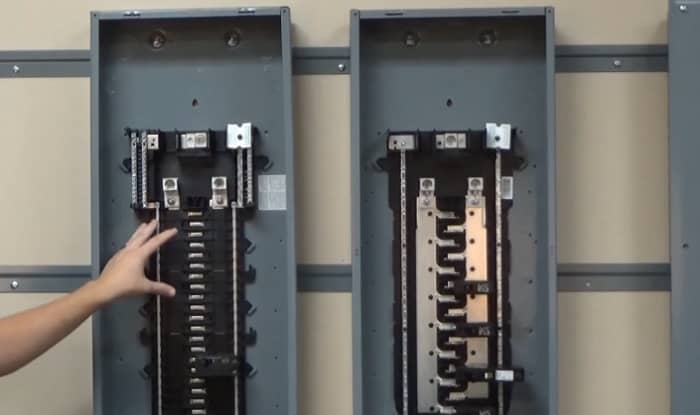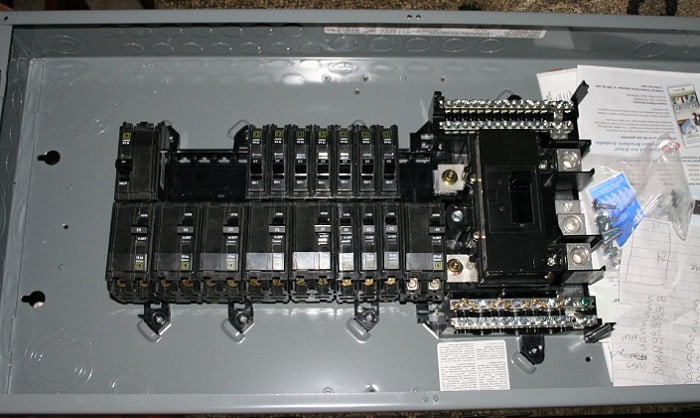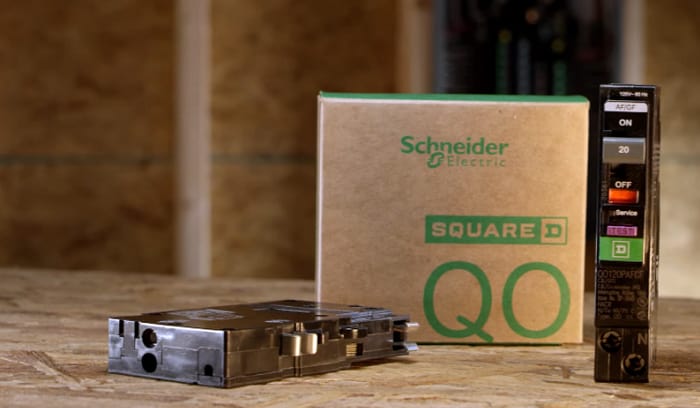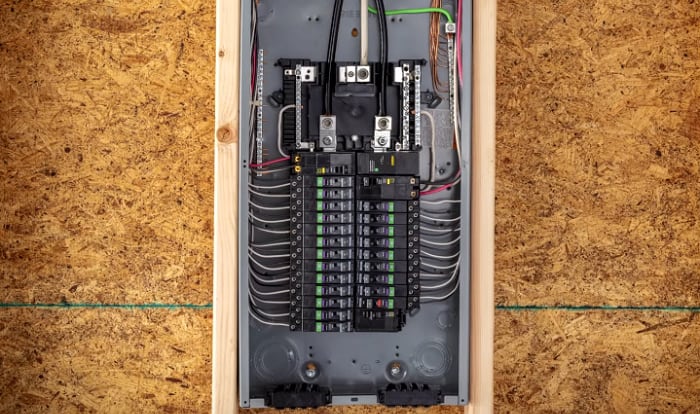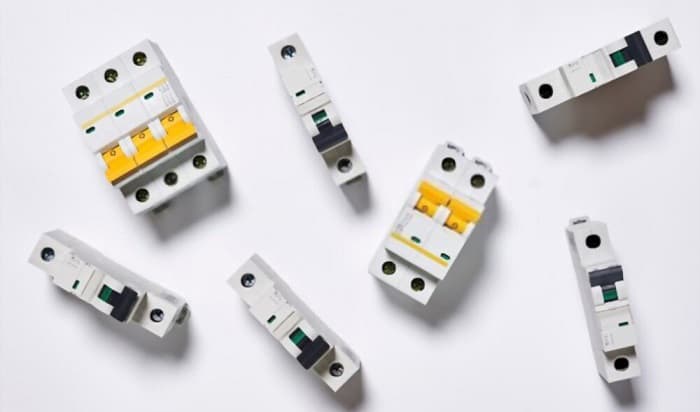Many homeowners dive into the Square D QO vs Homeline debate when they need a new panel or are doing a service upgrade. I’ve summed up the key points of this topic here:
- Homeline panels aren’t necessarily limited to residential applications, just as QOs aren’t restricted to commercial use.
- Homeline panels, while having limitations, tend to be more affordable and reliable for their intended (mainly residential) purpose.
- Some homeowners choose QO breakers because they’re longer-lasting and have additional features like a trip indicator window.
- Homeline and QO can’t interchange since they have different bus bars.
Read on for more details regarding Square D Homeline vs QO.
Table of Contents
What Is Homeline?
Homeline electrical panels are Square D’s budget-friendly options for most residential homes.
- Their primary features include tin and copper aluminum bus bars, plug-on neutral designs, and fully convertible feeds (mains, top, bottom).
- Compatible circuit breakers tend to be single-phase only with a 1” width and come in single and double-pole varieties.
- The circuit line is 70 to 225A, and there are up to 40
These specifications and features affirm that these panels are mainly designed for home use and small-scale remodels. However, they’re also sometimes present in agricultural and commercial setups.
How Does It Work?
Much like other standard breaker boxes, a Homeline panel protects against overloads and short circuits.
Since it’s a plug-on neutral load center, you’ll be able to use breakers that attach directly to a dedicated neutral bar. This often leads to a cleaner-looking panel that is devoid of the usual pigtail wires needed by conventional breakers.
To see how this load center differs from a standard one, consider watching this two-minute video:
What Is QO?
A Square D QO panel incorporates advanced features like the trip indicator window mentioned above. Coupled with the Qwik-Grip feature, this product heightens safety and ease of use.
- Their bus bars use shielded tin-plated copper.
- They support single or three phase setups.
- Breakers are either single-pole, double-pole, or triple-pole and come in ¾” width.
- Amperages range between 30 to 400 amps.
- Load centers have room for a minimum of 1 breaker, with panels containing 12 spaces and more supporting plug-on neutral connections.
- QO breakers exclusively incorporate a Visi-Trip indicator.
How Does It Work?
QO breakers protect against short circuits and overload as well. Once the Visi-Trip breaker trips, its handle snaps to the position between ‘ON’ and ‘OFF’. A red indicator light will turn on, allowing you to identify the breaker that flipped easily.
The higher amp ratings and more sophisticated features are what make QO ideal for heavy-duty applications, regardless of whether they’re residential or commercial.
You can see it for yourself by checking out the 42-space Square D 200 amp QO panel, for example.
Pros
Before we dive into the disadvantages of either one, let’s look at the advantages that both Homeline and QO panels bring to the table:
- Square D includes its trademark, time-saving Qwik-Grip wire management system in both Homeline and QO panels. It eliminates the use of excess knockouts, connectors, and filler plugs while ensuring a more clean-looking wire setup.
- Both are compatible with the Wiser Energy power monitor, which has a dedicated app that tracks energy use in real time.
- Having convertible mains allow Square D’s panels to fulfill changing requirements smoothly.
- With plug-on neutral load centers, you won’t have to deal with pigtail connections when providing GFCI and AFCI protection to your circuits.
- The backed-out neutral screws greatly shorten installation time.
For the cons of both the Homeline and QO, check out the comparison section below.
Square D breakers QO vs Homeline – All the Differences
1. General Differences
- It’s widely accepted that Square D QO panels are far superior to Homeline panels because of their design and more advanced and innovative features like theft prevention.
This is the general consensus on popular discussion platforms like Reddit.
- Only QO panels are available for three-phase circuits.
- Homeline panels use aluminum bus bars that lack the shielding and insulation found in QO panels. The latter panels use tin-plated copper for the said bars.
- QO panels are more expensive.
2. Breakers
- On the topic of Homeline vs QO breakers, breaker thickness is 1” and ¾” for Homeline and QO, respectively.
- Only QO panels can accommodate three-pole breakers.
3. Comparing Costs
Take note that QO and Homeline panels fluctuate in costs, especially if we’re looking at price tags found online. At best, they’re subject to external factors such as supply-chain shortages, such as those caused by COVID and Square D’s sourcing blunders.
Generally, though, Square D Homeline panels and breakers are cheaper than QO. However, there are times when Homeline costs balloon due to increased demand and the factors said above.
This goes to show that to some people, Square D Homeline circuit breakers and panels are equal to QO prices already.
- Panel Costs
If we’re going to use the main Schneider Electric website as a basis, we can see that the highest-costing Homeline 40-space 200A panel sells for only a little over $1,000, as of this writing.
That’s over $200 cheaper than the most expensive QO 42-space 200A breaker panel in the catalog.
Whether that’s a marginal difference is subjective, but considering the myriad of inimitable advantages you can enjoy from QO panels, the disparity makes sense.
- Breaker Costs
As far as breaker costs go, the price difference appears to be small, at least if we compare single-pole options available for both QO and Homeline. Most hover between $260 to $300+.
However, you’ll see QO double-pole breakers that cost well over $1,000, while similar Homeline models can reach up to $712.
Frequently Asked Questions
Are Square D QO and Homeline breakers interchangeable?
No, because they fit unique panels with different bus bars and have equally distinctive features that set them apart.
Will a QO breaker fit in a Homeline panel?
No, due to the difference in bus bar designs, you can’t slot QO breakers into a Homeline panel, and vice versa.
How do I know which Square D breaker I need?
Always take note of your property’s exact power requirements.
Moreover, know that a lot of the QO’s advantages like the Visi-Trip indicator can benefit anyone, regardless of the application (home or commercial).
That said, if you want to save more money and know that your home won’t need an extra-durable breaker, it’s probably best to settle for Homeline.
In short, make the most out of the perks offered by either product line.
What breakers are compatible with Square D Homeline?
Panels deemed as interchangeable are your safest bets. These include those made by Cutler-Hammer, Siemens, Eaton, GE, etc.
What are QOB breakers?
You won’t run out of options, as far as Square D breaker types are concerned. Aside from Homeline and QO breakers, the brand also makes a bolt-on kind called QOB.
In particular, QOB breakers will work with panels meant for old style Square D breakers like NQ and NQOB.
Conclusion
I hope this discussion centering on Square D QO vs Homeline has enlightened you about the main similarities and differences between these two breaker panels.
For the most part, QO models remain the favorite due to the value for money they deliver. Still, we can’t completely ignore Homeline’s standout perks.
Try to weigh your options based on the facts stated here while keeping your specific electrical requirements in mind.

I am Edwin Jones, in charge of designing content for Galvinpower. I aspire to use my experiences in marketing to create reliable and necessary information to help our readers. It has been fun to work with Andrew and apply his incredible knowledge to our content.

